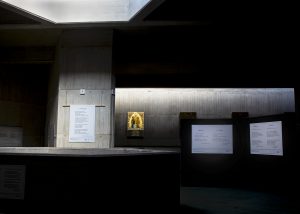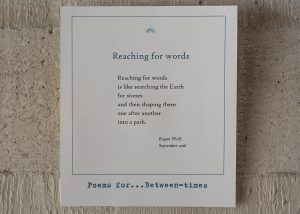When “Poems for… the wall” was piloted in London twenty years ago, it was a local affair. Some small poem-posters were put up in NHS waiting rooms in Hammersmith and Kensington. However, as the project became quickly better known and demand spread, it lost contact with an immediate locality. The poems went out far and wide, around the UK and then beyond, first by post and later digitally, downloaded from this website. In those circumstances, the co-ordinator’s bike tended to stay at home and I knew rather little of what actually happened to the poems, once they arrived at their destination.
But now I’m in Bristol and the bike is out again. Earlier this hot Summer of 2018, two local schools exhibited poems from the “Self at Sea” collection as part of their response to Mental Health Awareness week. Poems were enlarged to A1 and A2 and A3 on foamex board half a centimetre thick. Being writ large suits the poems and they had significant impact, I understand. The teachers used the opportunity well and imaginatively. Here are comments from two of them :
“…What was so fantastic about this was that it enabled questions and conversations around this topic to take place. I was therefore able to dispel myths, allay concerns and tackle the stigma surrounding mental health. Again, this is a rare and valuable opportunity for that to happen amongst peers and within the safe community of a school.”
“…The poetry was beautifully displayed and of a high calibre. I think it’s so important for the students to explore mental health. It has definitely led to a greater understanding of mental health for the students, but also helped me get to know how some of the students’ families have been affected by mental health issues too…”
And there was a long-standing exhibition of them on the wall of a popular local café called Beacon House, run by Bristol University, near the Wills Monument in Clifton.
Finally, here is a little Summer anecdote :
This year, the NHS was 70. In its 60th year, the NHS commissioned Michael Rosen to write a poem celebrating its work. He came up with a poem of wonderful simplicity and directness called “These are the Hands.” I saw it and asked him, could the “Poems for…the Wall” project adopt and display it ? Yes, he said. Good idea. So I did and it’s up and still available on the project’s site. You can find it in the “One World collection.” Here is the link.
Then I asked Michael, how about translating it into several languages ? People of many mother tongues receive help from, and work within, the NHS. And I am lucky to know people willing and able to provide distinguished translations in their own mother-tongues. Good idea, said Michael. So I did, : into Greek, Turkish, Somali and Punjabi – in both its Gurmakhi and Arabo-Persian forms. All these versions of the poem can be found among the same collection.
But that was a round a decade ago. This year, in 2018, with Brexit swirling through the UK corridors, I suddenly thought that Michael’s poem was just as relevant in 2018 as it had been in 2008. Even more poignantly so, in fact, as the NHS is under great strain these days, along with much else that bound us together as a people and a nation. And these days, we had Facebook (for good and for ill). In 2008 we did not. Michael’s poem would look good on Facebook, I thought. So I uploaded the poem in Portrait format on my Facebook timeline and it looked very good.
Within days, my Facebook copy of Michael Rosen’s poem had been shared 5,209 times, and liked/loved 1,145 times. That’s quite a lot, almost viral, I’d say. Michael shared it on his timeline too and – separately – attracted similar numbers. In addition, I put the poem up on my own blog, and it looked just as good on that. Here : https://roganwolf.com/2018/07/03/the-70th-birthday/ And about ten days later, The Guardian also reproduced the poem, ten years old, but still absolutely present, perhaps in a sense ever more present.
And I am wondering about the nature of the response to the poem which we witnessed here. The Brexit issue filled the nation’s news coverage day after day and it was and is so divisive and so utterly bewildering, almost suffocating. I think it shames this nation. The NHS is an altogether clearer and better cause and something we can be proud of. We are not – by and large – divided on that. Yet the NHS is in trouble, starved year on year of the resources it needs. And we are still being governed by a political party that believes in low tax and instinctively hates a strong state.
I have a strong feeling that the enthusiasm for Michael Rosen’s poem “These are the Hands,” which we witnessed in these weeks, was not just the result of the poem’s eloquence, nor due only to the enduring popularity of the NHS, but also because the people who responded recognised that the NHS was under threat and in the wrong hands just now.



 A busy gathering place for students, staff and visitors from all over the world is not where you’d normally expect to find an exhibition of poster-poems.
A busy gathering place for students, staff and visitors from all over the world is not where you’d normally expect to find an exhibition of poster-poems.